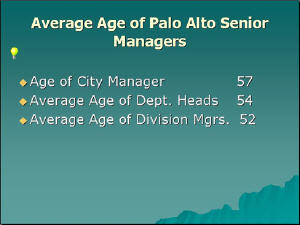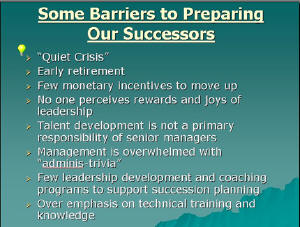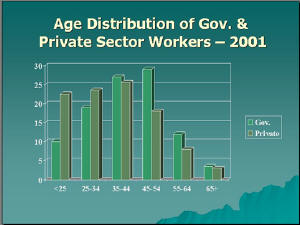Here are a few slides and statistics from Dr. Benest's presentation which illustrate the issue.
 |
One slide in Dr. Benest's presentation quotes a statistic from the General Accounting Office stating that 53% of all government employees are eligible to retire! Dr. Benest identifies four causes: lack of succession planning, anti-government bias, value trends, and less time for traditional on-the-job mentoring.
Others have observed this trend. Below is a quote from a research report on government recruiting titled "Back to School: Rethinking Federal Recruiting on College Campuses" by the Partnership for Public Service.
These findings come at a critical time for the federal government, which has been struggling to attract and retain talented employees as hundreds of thousands of "baby boomers" approach retirement. Of the 1.9 million people currently serving in the federal government, 44 percent will be eligible to retire by 2010 - including 60 percent of senior managers. While the country has invested heavily to understand how to attract the talent we need for our military, the federal government - our nation's largest employer - has invested little to understand how to attract quality civil servants, particularly among younger people. … Young people have become an endangered species in our federal workforce, only 3 percent of the federal workforce is currently under 25.Doing the math, 3% of 1.9 million federal workers equals a grand total of 57,000 people under 25. Another report from this same source discusses the recruiting process, saying it is out-of-date; the time from initial application to hire is six months to a year. Unless you get a temporary job at Wal-Mart, are living at home after graduation, and are really dedicated to working for the government, chances are you would opt instead for private enterprise, with a shorter hiring cycle, more money and a quicker path to the BMW.
An article from the Chronicle of Higher Education makes a similar point.
A survey of more than 3,000 college juniors and seniors that was conducted for the report found that 42 percent said they were "extremely or very interested" in working for the federal government. But only 13 percent said that they were "extremely or very knowledgeable" about job opportunities in that sector.This is followed by a quote from Max Stier, president and chief executive officer of the Partnership for Public Service.
In order to fulfill the promise of American democracy, we need to re-establish the federal government as an employer of choice for our country's talented young college graduates…Hmmm … who is going to keep things running? If everybody is about to retire, recruiting is problematic, and there are no young people coming into government, what is to be done?
Clearly there's a marketing opportunity here, with two choices. First, the recruiting problem and hiring cycle time have to be fixed. Second, how about outsourcing? If 60% of senior managers are about to retire, why couldn't they re-form their departments in the private sector and offer services to their original government entity? This pushes the hiring problem down to the private company that is offering the outsourced services, and away from government. As a rule, private enterprise is faster on its feet than government, so maybe it could better tackle this problem.
Dr. Benest clearly identifies the overall problem in this last slide. His bullet points are not limited to government - they could exist in any organization. It's still just a quiet crisis because so far, everybody is still coming to work. Consider this - many people think we have "too much government." What happens if we don't have enough government to keep things running? Yet, I can't help but think what fun it would be to allow the voters to pick which parts of the government stayed in business!
The cities of Palo Alto and Walnut Creek have recognized the problem and are seeking answers. Wouldn't it be wise to know what your local government is doing?
 |
About Dr. Frank Benest
Frank Benest is the city manager of Palo Alto, California. He is a noted consultant and trainer on rightsizing public organizations, entrepreneurial government, and civic engagement.
Prior to his appointment in Palo Alto, Frank served as city manager in Brea and Colton, California. He has a doctorate in management from Brigham Young University; a Masters in Public Administration from California State University, Long Beach; and a Bachelor of Arts degree from Yale University. Frank is a Credentialed ICMA Manager.
